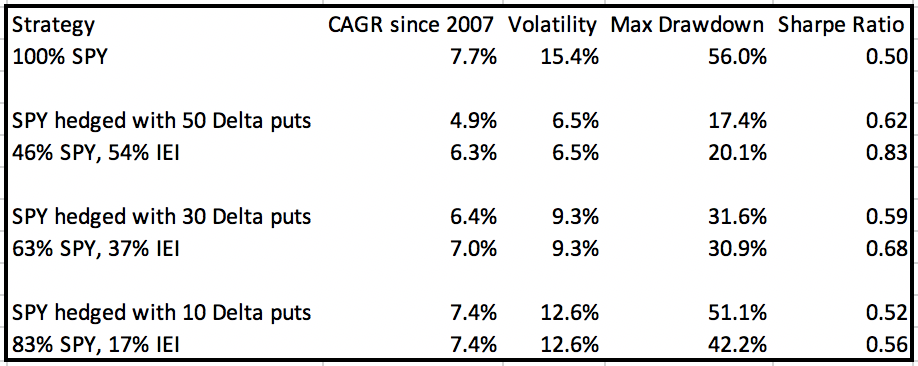
Using the most popular S&P 500 ETF (SPY) to represent the US stock market, this article will look at different ways to manage equity market risk using historical ETF and options data from ORATS Wheel since 2007. We will analyze the following unhedged, hedged and allocation choices:
- Unhedged exposure to SPY.
- Fully hedged exposure with at the money puts.
- Partially hedged exposure with out of the money puts.
- And a more simple approach of reduced allocation to SPY with the proceeds allocated to an intermediate term US Treasury ETF (IEI).
In the following data, I’m showing the hedged portfolios compared to the stock/bond portfolios scaled to have similar volatility. The option hedge parameters entered into the ORATS backtester targets the contract closest to one year from expiration and rolls the contracts at 45 days from expiration. The idea of going further out in time and rolling prior to expiration is to reduce the impact of negative theta (time decay) that you experience with long puts. I did not attempt to optimize the parameters that would result in the best hedging results. With the stock/bond portfolios, rebalancing is assumed to occur based on 5/25 rebalancing bands that can be replicated using Portfolio Visualizer and all results include the reinvestment of dividends. Past performance doesn’t guarantee future results. Now to the data.

What we see is not surprising based on published research I’ve reviewed from multiple sources. Hedging with puts has been documented to be inefficient due to the volatility risk premium (VRP) built into option prices, making it more effective to simply lower equity allocation and use the proceeds to buy safe bonds (IEI). A stock/bond ETF or mutual fund portfolio is also much easier and less costly to manage. If buying puts produces poor long-term risk-adjusted results, it then means that selling them may produce attractive long-term risk-adjusted returns. That is the strategy we attempt to capitalize on in the Steady Momentum PutWrite service.
In the AQR podcast episode “diversify or hedge?”, the hosts discuss how a portfolio of equities and cash (or safe bonds, as in my example) produces better long-term results than hedging with puts. AQR also has a research paper titled, “Pathetic Protection: The Elusive Benefits of Protective Puts” which concludes that “because of path dependent outcomes and option expensiveness, put options may do more harm than good.
An alternative approach to protection that investors can take is increasing diversification. ”Hedging with puts" can still be a rational decision if an investor wants to protect from a near or complete loss of value in the stock market (and is willing to pay for it), at which point the outcomes would favor the hedging approach as opposed to the stock/bond approach. The goal of this article is to simply make investors more aware of the different choices they can make with regard to risk management and the expected outcomes related to those choices.
Jesse Blom is a licensed investment advisor and Vice President ofLorintine Capital, LP. He provides investment advice to clients all over the United States and around the world. Jesse has been in financial services since 2008 and is aCERTIFIED FINANCIAL PLANNER™professional. Working with a CFP® professional represents the highest standard of financial planning advice. Jesse has a Bachelor of Science in Finance from Oral Roberts University. Jesse manages theSteady Momentumservice, and regularly incorporates options into client portfolios.
What Is SteadyOptions?
Full Trading Plan
Complete Portfolio Approach
Diversified Options Strategies
Exclusive Community Forum
Steady And Consistent Gains
High Quality Education
Risk Management, Portfolio Size
Performance based on real fills
Non-directional Options Strategies
10-15 trade Ideas Per Month
Targets 5-7% Monthly Net Return
Recent Articles
Articles
Pricing Models and Volatility Problems
Most traders are aware of the volatility-related problem with the best-known option pricing model, Black-Scholes. The assumption under this model is that volatility remains constant over the entire remaining life of the option.
By Michael C. Thomsett, August 16

- Added byMichael C. Thomsett
- August 16
Option Arbitrage Risks
Options traders dealing in arbitrage might not appreciate the forms of risk they face. The typical arbitrage position is found in synthetic long or short stock. In these positions, the combined options act exactly like the underlying. This creates the arbitrage.
By Michael C. Thomsett, August 7

- Added byMichael C. Thomsett
- August 7
Why Haven't You Started Investing Yet?
You are probably aware that investment opportunities are great for building wealth. Whether you opt for stocks and shares, precious metals, forex trading, or something else besides, you could afford yourself financial freedom. But if you haven't dipped your toes into the world of investing yet, we have to ask ourselves why.
By Kim, August 7

- Added byKim
- August 7
Historical Drawdowns for Global Equity Portfolios
Globally diversified equity portfolios typically hold thousands of stocks across dozens of countries. This degree of diversification minimizes the risk of a single company, country, or sector. Because of this diversification, investors should be cautious about confusing temporary declines with permanent loss of capital like with single stocks.
By Jesse, August 6

- Added byJesse
- August 6
Types of Volatility
Are most options traders aware of five different types of volatility? Probably not. Most only deal with two types, historical and implied. All five types (historical, implied, future, forecast and seasonal), deserve some explanation and study.
By Michael C. Thomsett, August 1

- Added byMichael C. Thomsett
- August 1
The Performance Gap Between Large Growth and Small Value Stocks
Academic research suggests there are differences in expected returns among stocks over the long-term. Small companies with low fundamental valuations (Small Cap Value) have higher expected returns than big companies with high valuations (Large Cap Growth).
By Jesse, July 21

- Added byJesse
- July 21
How New Traders Can Use Trade Psychology To Succeed
People have been trying to figure out just what makes humans tick for hundreds of years. In some respects, we’ve come a long way, in others, we’ve barely scratched the surface. Like it or not, many industries take advantage of this knowledge to influence our behaviour and buying patterns.

- Added byKim
- July 21
A Reliable Reversal Signal
Options traders struggle constantly with the quest for reliable
By Michael C. Thomsett, July 20

- Added byMichael C. Thomsett
- July 20
Premium at Risk
Should options traders consider “premium at risk” when entering strategies? Most traders focus on calculated maximum profit or loss and breakeven price levels. But inefficiencies in option behavior, especially when close to expiration, make these basic calculations limited in value, and at times misleading.
By Michael C. Thomsett, July 13

- Added byMichael C. Thomsett
- July 13
Diversified Leveraged Anchor Performance
In our continued efforts to improve the Anchor strategy, in April of this year we began tracking a Diversified Leveraged Anchor strategy, under the theory that, over time, a diversified portfolio performs better than an undiversified portfolio in numerous metrics. Not only does overall performance tend to increase, but volatility and drawdowns tend to decrease: